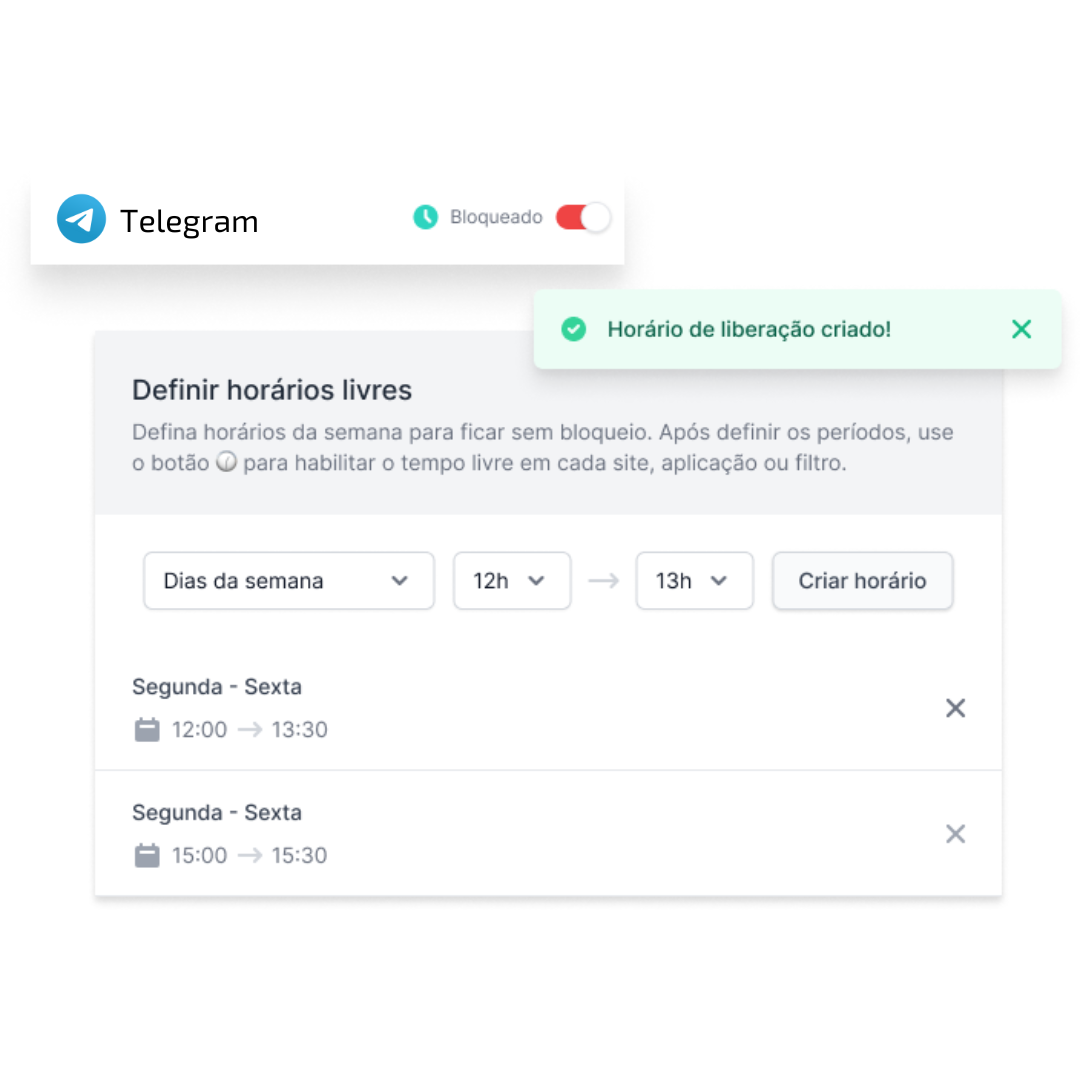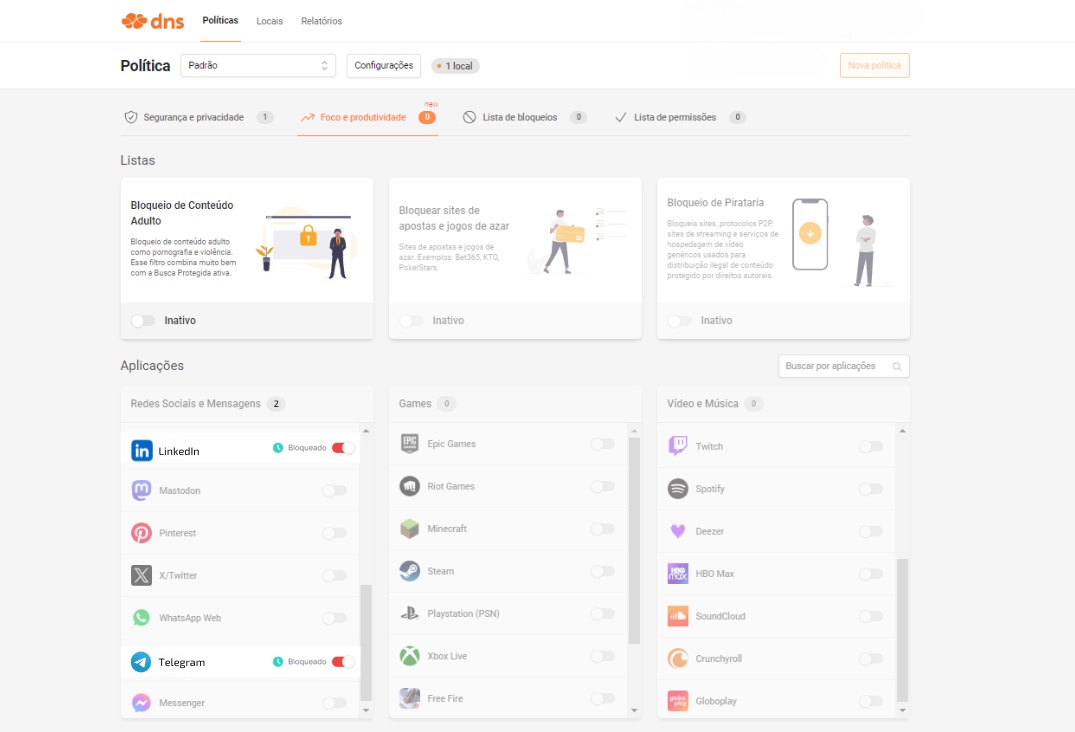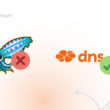The use of digital platforms like LinkedIn and Telegram has grown exponentially within the work environment in recent years. According to a survey conducted by the LinkedIn platform, Brazil occupies the fourth position among the main users , being the sixth most used social network in the country. With 75 million active users , using the platform can be very harmful to companies when used indiscriminately.
Regarding Telegram , although in the period from 2023 there was a drop from 66% to 63% in users of the country , the platform still has millions of users and has been increasingly used. According to data provided by the platform itself, Telegram has a total of 950 million monthly active users, having stood out for its great ability to facilitate communication efficiently and quickly between teams, being widely used for both formal and informal conversations within companies.
LinkedIn , in turn, has consolidated itself as an essential platform for professionals who want to expand their contact networks, seek new opportunities and strengthen their personal brands .
LinkedIn in the workplace
As mentioned earlier, LinkedIn has become an indispensable tool for professionals seeking recognition and growth in their careers. In the workplace, the platform is much more than just an online curriculum mode; It is a space for learning, creating opportunities and exchanges of experiences. Many companies encourage their employees to keep their profiles updated on the platform, participating in relevant groups and establishing the interaction with content that adds value to their area.
In addition to connecting professionals, LinkedIn offers a wide range of resources for companies to strengthen their corporate brands. Regular events and news posts maintain the company visible on the market and attractive to future talents. For employees, this visibility is an excellent opportunity to highlight their contributions and receive due recognition.
However, the use of LinkedIn in the workplace should be done with balance. Although it is a rich platform in opportunities, inappropriate use and movements can affect productivity considerably. For this reason, it is essential for companies to establish clear limits for the use of the network during working hours.
Professional Benefits of LinkedIn
Thanks to its numerous tools, LinkedIn offers several benefits to the professional development of employees. In addition to providing access to a vast network of essential career contacts, the platform also facilitates collaborations, mentoring and new job opportunities.
In addition, the platform allows users to track market trends and stay up to date on best practices in their areas. LinkedIn , helping professionals to remain increasingly competitive.
Another great advantage is that it allows the construction of a solid personal brand. Knowledge sharing and active participation in relevant discussions makes professionals be able to position themselves as experts. This not only increases individual visibility, but also contributes to the strengthening of the company's image.
Building Networks: Networking and Business Opportunities
Networking LinkedIn 's main pillars be treated as a great growth opportunity. In addition to building robust professional networks and creating strategic partnerships, the platform allows you to exchange experiences, share knowledge and identify beneficial opportunities.
LinkedIn also allows interactions to happen in a continuous and significant way . Comment on posts, participating in discussion groups, and sharing content are intelligent and efficient ways to stay active and visible on the network. This visibility is extremely important for business opportunities to emerge organically.
Companies that encourage their employees to use LinkedIn for networking can reap excellent fruits. The creation of new partnerships, identifying new markets and attracting customers are just some of the benefits that the platform can allow to achieve.
Personal brand development
Developing a consolidated personal brand is essential for success in the professional environment, and LinkedIn is the best platform for this. A well -established personal brand helps the professional stand out in an increasingly competitive job market. Sharing achievements, insights and knowledge will also allow the user to position himself as an authority in their respective area of expertise.
There are numerous examples of success in this field, such as professionals who regularly publish relevant content and bring engagement with their networks, being recognized as leaders of thought. As for example, Maurício Benvenutti (startups and innovation expert), Rodrigo Dantas (CEO of Startup) and Murilo Gun (speaker and creativity specialist). These users use LinkedIn as a powerful platform for personal brand development.
As a result, these professionals receive several invitations to lectures, publications in specialized magazines and even new job opportunities. This demonstrates how LinkedIn is in the mold and strengthening of its users' careers.
For companies, having employees with strong personal brands is also a great asset. These professionals give recognition and prestige to the organization, as well as attracting talent and business opportunities. Therefore, the encouragement of personal brand development on LinkedIn is a strategy that can benefit both parties.
LinkedIn as a recruitment tool
In addition to all the advantages we mentioned earlier, LinkedIn has also revolutionized the way recruitment is performed by companies. With a huge professional database, the platform has become an indispensable tool for recruiters who seek to identify and attract the best talents. With the help of advanced filters, it is possible to find qualified and experienced candidates, meeting the needs of the company and streamlining the selection process.
In addition, LinkedIn allows recruiters to access a broader spectrum of candidates. In an increasingly globalized and connected world, companies can look for talent in different parts of the world. Thanks to Linkedin , the traditional barriers of recruitment are broken, allowing a more efficient and directed search.
The ability to analyze the full profile of candidates, including their recommendations, connections and activities, is also another very important aspect. This provides a more holistic view of the professional, going beyond what is only described in the curriculum. This means that LinkedIn not only facilitates recruitment, but also improves the quality of hiring, helping companies find the ideal candidate.
LinkedIn and Productivity: a delicate balance
Although LinkedIn offers numerous benefits to users and companies, it is important to remember that their use in the workplace should happen in a balanced way. The line between productivity and distraction is quite thin, and excessive use of the platform can impair employee efficiency and focus. Despite being a very useful tool for professional development, LinkedIn can also become a source of procrastination.
The key to maintaining balance is to set limits. Companies can adopt policies that allow you to access LinkedIn at specific times, such as after working hours and during intervals. This will ensure that employees can enjoy the benefits of the tool without compromising their responsibilities.
In addition, employees should be aware of the impacts of LinkedIn's excessive use on their productivity. Maintaining a focus on priority tasks and avoiding constant platform checking helps minimize distractions and avoid errors due to lack of focus. The purpose of this control is to ensure a more productive and suitable work environment.
Distraction during work
Despite the numerous benefits of LinkedIn , it can also be a significant source of distractions in the workplace. Easy access to the platform and constants updates can divert attention from employees, negatively impacting their productivity. Often, just checking updates can turn into long navigation sessions that steal precious time for company -related tasks.
In this sense, notifications of new connections, interactions and messages also interrupt the workflow and make it difficult to concentrate and comply with deadlines. Although it is a work -related platform, its social nature and the possibility of real -time interactions can contribute to the sense of urgency to interact or respond, creating a distraction chain that has major impacts on performance.
To combat this problem, it is essential that employees learn to manage their time more effectively, establishing specific times to use LinkedIn. In addition, disabling notifications during working hours is also a very useful strategy for avoiding interruptions and focusing on essential tasks.
Personal and professional relationships: how to find balance
One of the biggest traps present in LinkedIn is the difficulty in separating personal interactions from professionals. Although focused on professional networking, the platform can confuse borders and negatively impact employee productivity and reputation. Maintaining a balanced and professional profile is essential to prevent these lines from crossing in a harmful way.
An example of this is accepting connections from close or family friends, which, although it may seem harmless, can lead to interactions that divert the focus from work. Comments that are not aligned with the professional context can also create a mistaken image, impairing productivity and affecting the user's credibility on the network. It is crucial that professionals use LinkedIn consciously, always focusing on professional goals and avoiding posts that can be seen as personal.
In addition, interaction with co -workers on the platform should be done with a professional posture. Heated discussions and inadequate comments can extrapolate the network boundaries and impact relationships within the company. Defining clear boundaries for interactions and being aware of what is shared are essential to maintaining productivity and protecting the professional image.
Strategies to maximize benefits and minimize distractions
For LinkedIn to be a truly effective resource in the workplace, it is necessary to adopt strategies to maximize its benefits and minimize distractions. A recommended approach is to set clear goals for the use of the platform. For example, you can set a specific time of the day to check updates and share content.
Time management tools also allow employees to monitor how long they are spending on LinkedIn and adjust their activities as needed. Applications and programs that block or limit access to certain sites during working hours may also be useful to ensure that the use of LinkedIn does not interfere with priority tasks.
It is the company's role to raise awareness and educate its employees about the conscious use of the platform. Training and workshops can teach employees how to use resources strategically by aligning their activities on LinkedIn with professional goals, promoting productivity and efficiency.
Definition of internal policies
The implementation of internal policies for the use of LinkedIn in the workplace is critical to ensuring that the platform is used productively and aligned with the organization's objectives. These policies should provide guidelines on when and how employees can access and use the platform during office hours, ensuring intelligent use that does not interfere with daily responsibilities.
The creation of specific times for the use of LinkedIn, as during breaks or at times of lower demand, is also quite efficient. This strategy will allow employees to enjoy the benefits of the network without compromising productivity. In addition, policies should guide employees to maintain a professional posture on the platform, avoiding interactions that may undermine the image of the organization or even the employee.
Companies can offer training so that employees understand that using LinkedIn strategically and productively can be very beneficial. These training can include tips on profile optimization, effectively connection with professionals and content sharing that adds value. The implementation of clear internal policies will promote conscious use of LinkedIn and ensure that the platform is an ally in search of results and professional growth.
Use of tools and settings
To focus on relevant activities, you must use the tools and settings available on the platform . One of the most useful features is the ability to customize notifications by choosing to receive those that are really relevant to the user. This will reduce unnecessary interruptions and maintain concentration on priority tasks.
The use of time management applications allows more assertive control of time spent on LinkedIn and other digital platforms. You can set these applications to limit use time and send alerts when the employee exceeds the time for network activities.
Creating task lists or daily goals related to the use of the platform can help employees focus on. Setting specific goals, such as sharing a certain amount of content or connecting with a certain number of people, can help control the use of LinkedIn. With these strategies, it is possible to use the platform as a powerful networking and professional development tool without compromising work efficiency.
Telegram in the work environment
Like LinkedIn, which hit 75 million users in 2024 , Telegram has become an increasingly popular communication tool with 900 million monthly users . Offering a number of advantages over other message applications, Telegram has an intuitive interface and more advanced features, allowing teams to collaborate more efficiently and organized. In addition, it also has end -to -end encryption, ensuring that communications remain private and safe.
One of the biggest advantages of using Telegram in the corporate environment is its ability to support large groups of users, with up to 200,000 members . This is useful for companies with large or distributed teams in different locations, allowing them to share relevant updates, documents and information in a centrally.
Telegram also allows integration with bots and other tools, automating processes and facilitating the management of activities . These features help improve communication efficiency and make it more agile and direct. However, just like any other tool of this type, it is important to manage and control its use effectively.
Advantages of using telegram for communication in the workplace
Telegram offers numerous advantages as a communication tool for companies, especially for their functionality and flexibility . One of the main advantages is real -time communication capacity, allowing all teams to solve questions quickly and without the need for formal meetings to do so, being especially useful in situations where agility is crucial. The Panorama Mobile Time/Opinion Box - Messenger in Brazil of August 2022 showed that Facebook Messenger (52%) was exceeded by Telegram (54%) regarding consumers' preference.
Another significant benefit of Telegram is the ability to organize communications in groups and channels. You can create a channel for each project or team, where it centralizes and shares the information, facilitating access and preventing important data from getting lost in emails or other conversations. In addition, Telegram allows the setting of important messages at the top of the channels , ensuring that all members have access to the information.
This tool is also highly customizable according to preferences. This helps to minimize distractions and ensures that employees can focus on the most relevant tasks and are staying accessible to urgent communications. These advantages make Telegram a very effective tool to improve communication and collaboration in the workplace.
Agile communication and effective collaboration
Agile communication is one of the main benefits of using Telegram in corporate environments. The platform allows teams to communicate quickly and directly, eliminating the need for unnecessary meetings or long emails. This agility is essential in the increasingly competitive and connected job market, delivering a great ability to respond to challenges and opportunities faster.
Telegram also allows collaboration between teams, especially those who work remotely or act on different times . Groups and channels allow document sharing, exchange of ideas and real -time problem solving, regardless of where they are located. This increases the efficiency and cohesion of the team, resulting in better results for the company.
The ability to integrate Telegram with other work tools is another important aspect. This allows teams to centralize their communications and keep all members updated on processes and project progression, facilitating decision making and performing tasks.
Organization of work groups and channels
The efficient organization of Telegram groups and channels is crucial to ensuring productive and efficient communication . The platform has the ability to create large groups, where several employees can interact simultaneously. Organizing these groups by project, department or function facilitates the exchange of messages between teams and ensures that information reaches the right people.
In addition to groups, channels offer an effective way to share information in a unidirectional way. These channels can be used to distribute official communications, update projects or any other information that needs to be shared with a large number of people.
To maximize your company's efficiency, define clear rules on the use of groups and channels by employees. Determine who can create new groups, which channel categories should be used, and how to manage message sending permissions. Using a proper organization, Telegram can be a valuable central tool in corporate communication.
Risks associated with the use of telegram
Although Telegram offers several advantages, there are risks associated with its use in the workplace that need to be considered. The main challenge is the possibility of constant interruptions due to the large number of messages and notifications. Considering that the corporate environment requires constant concentration, these interruptions can significantly affect employee productivity.
The mix of professional and personal communication is another significant risk. As Telegram is widely used for personal communication, there is a fine line between professional and personal use . This mixture can lead to situations where inadequately sharing confidential or sensitive data, or where relaxation causes problems in the formality required in communications within the company.
Lack of control over the use of Telegram can lead to the dissemination of wrong information or inadequate communications. Companies must implement clear guidelines for using the tool, ensuring that it is used for the good of the corporation.
Constant interruptions and notifications
Constant notifications are a real problem in using Telegram in the workplace. Although agile communication is an advantage, frequent interruptions can become a significant source of distraction for employees. With the constant arrival of notifications, they may end up interrupting the workflow, impairing concentration and delaying the completion of activities.
To combat this problem, it is essential that employees adjust the notification settings of Telegram. The platform allows users to choose the groups and channels that should send notifications and how often. Disable notifications of less relevant or urgent groups, or even configure specific times to check these messages, can help reduce interruptions.
It is also necessary for the company to educate its employees about the importance of managing notifications effectively. Training and workshops can teach you how to configure Telegram notifications in a way that reduces distractions and maintain focus on what is really important for the organization.
PERSONAL AND PROFESSIONAL: FOOD LINES
In the work environment, mixing the line between the professional and the staff can be a real problem. The use of platforms like Telegram can blur these lines between these types of communication and create challenges for the management of productivity and internal relations. Since people use the tool widely for personal communications, it is natural that they mix interactions and take situations where informal conversations permeate the work environment.
The mix of personal and professional communication can create ethical and privacy dilemmas . Personal data and sensitive information can be involuntarily exposed, and the lack of clarity on the boundaries of what is really acceptable can generate discomfort among employees.
It is essential for companies to establish transparent and achievable guidelines on the use of Telegram for professional purposes, encouraging the separation between staff and professional to avoid problems. A recommended practice is the creation of separate accounts for personal and professional use on Telegram. This helps keep interactions within an appropriate context and prevent personal messages from causing interference with work activities.
Telegram and Productivity: How to keep the focus?
Keeping focus on using Telegram in the workplace is critical to ensuring that the tool is an ally of productivity, not a source of constant distraction. One of the first measures that employees can take is the adjustment of notification settings , as mentioned earlier. NOTIFICATIONS Personalization will ensure that only the most relevant messages cause interruptions of activities, ensuring more efficient time management.
In addition to these settings, another effective strategy is the organization of time of use . Establishing specific moments of the day to check and respond messages helps to avoid dispersion and ensures that priority tasks are completed. This practice, known as a team blocking , is especially useful in environments where constant communication is necessary, but cannot interfere with critical activities.
Companies can encourage the use of time management in conjunction with Telegram. There are applications that monitor time spent on different activities and provide valuable insights on how employees are using Telegram. With these approaches, it is possible to use this tool productively and intelligently, maintaining focus on the results of the company.
Configuration of notifications and channels
The proper configuration of Telegram channels and notifications is one of the keys to maintain productivity in the company. Because Telegram allows advanced customization, users can adjust notifications according to their needs. For example, it is possible to silence groups and channels that are less relevant and ensure that only important messages are notified.
In addition, the organization of these groups is crucial. Creating specific channels for different projects or departments will allow you to segment information more intelligently, preventing employees from receiving irrelevant messages. Defining clear rules for other channels, how you can post and what type of content is appropriate, will help maintain more efficient communication.
To ensure that employees use these settings effectively, it is possible to provide training on the use of the platform . These training can teach basic notification settings, advanced channel organization strategies and time management.
Establishment of rules and guidelines
It is very important for the company to establish clear rules and guidelines for the use of Telegram in the workplace. With this, it is possible to ensure that the tool is used productively and aligned with the objectives of the organization. These guidelines will cover aspects such as the creation of groups, channels, notification management and moderation of communications, bringing as a focus on the minimization of distractions.
The definition of specific times for the use of Telegram during office hours is quite intelligent. For example, encourage employees to check messages and notifications at defined intervals or at times of less demand, preventing this flow of messages from interrupting critical tasks.

It is also possible to institute regular training to ensure that all employees are using the tool properly. These training should include notification configuration guidelines, platform use strategically, and channel organization. Using well -defined rules and guidelines, Telegram can be a very effective tool for improving communication and collaboration in the workplace.
Comparison of LinkedIn and Telegram impact on productivity
When we try to analyze the impacts of LinkedIn and Telegram on workers productivity, it is necessary to consider differences in the way these platforms are used. People usually use LinkedIn because it is a professional social network for networking, personal brand development and recruitment. While, on the other hand, Telegram is an instant communication tool that facilitates the exchange of information and collaboration between teams. The main difference between these two platforms is the type of distraction they cause. While LinkedIn leads to loss of focus due to its social network nature, Telegram, with its constant notifications, can cause frequent interruptions, making it difficult to maintain concentration in essential tasks.
Despite these clear differences, manage both platforms to minimize negative impact on productivity. The implementation of internal policies , the use of time management tools, and the implementation of a culture of conscious use are essential to ensuring that these tools are used in a way that support productivity in the workplace.
Distractions and productivity: a comparative
It is important to understand that distractions are directly related to the loss of productivity within companies. It is crucial that employees use the time available to perform the essential tasks that contribute to the continuity of business and success of the organization.
In this sense, it is essential to combat tools and resources that end up causing constant distractions in the workplace. When it comes to Telegram and LinkedIn, we need to understand that these tools are often essential to maintaining the continuity of communication and also to strengthen the company's brand, and should establish use with caution and intelligence.
Successful cases and failures
Several companies have different experiences using LinkedIn and Telegram. Successful cases often involve organizations that use LinkedIn to generate leads and build contact networks using the platform in the development of valuable business relationships. Through well -planned strategies, these companies are able to get a positive return with LinkedIn in terms of business opportunity and networking.
However, when using the platform inappropriately or excessively, some companies face challenges. Lack of focus on specific objectives and information overload may decrease the effectiveness of using LinkedIn for professional purposes. In the case of Telegram, these flaws occur due to excessive use of groups and channels, which create a chaotic and distracted work environment.
It is necessary to analyze success and failures to provide valuable insights on platform management effectively. By including practices that contribute to positive results, it is possible to avoid those that can compromise productivity.
Case studies and effective implementation
Starting from the list of the 300 largest advertisers on the market , more than 9,000 posts were analyzed on LinkedIn to determine the engagement of these profiles. Considering the public metrics made available by the platform, the level of engagement and the sum of the total volume of interactions, it is possible to determine how this platform can bring good results to the company.
At the top of the list, Daniel Waxwaser , Vice President of Ambev, followed by Roger Corassa , marketing leader of Volkswagen do Brasil, and Alexandre Nogueira , responsible for Bradesco Seguro. Although there is no predominance in the sectors, there are similarities in these profiles. The way consumers see the brand and how it exposes itself in the market is closely linked to its presence on LinkedIn.
Common errors and lessons learned
One of the most common errors between companies and professionals is to underestimate the true impact that uncontrolled use of social networks and messaging applications can have on the organization's productivity. A survey conducted by ComScore showed that Brazil is the third country in the world that most consumes social networks, with 131.5 million connected users. Continuous use of these platforms without a defined strategy can lead to dispersion and waste of time with activities that do not add value to work. Many companies fail to establish clear guidelines and result in a working environment prone to distractions and loss of productivity.
The lack of distinction between the professional and the staff during the use of these tools is also a recurring failure. Employees end up using LinkedIn to navigate posts that are not related to work or participating in irrelevant discussions in Telegram groups, reducing their time available to performing essential tasks. Lack of effective management or challenges in controlling the use of these platforms can be problematic.
In this scenario, the lessons learned show that it is necessary to have use policies , encourage employees to consciously use these tools and have more assertive control. Finding the balance between beneficial use and distractions is essential to implement control mechanisms that help maintain work at work.
Tools and Techniques for Social Network Management and Message Applications
There are already several techniques and tools that can help companies manage the use of these platforms with more intelligence. One of the most effective techniques is the creation of specific times for the use of these tools, such as checking only at certain times of the day. The use of selective notifications and the separation between professional and personal profile also helps improve the focus of priority activities.
In terms of tools, platforms such as Microsoft Teams and Slack are more viable alternatives to direct and control communication. They can be used to replace Telegram in the corporate environment and ensure smarter control of what is debated within the workplace. Post automation tools can also help manage LinkedIn use more efficiently, allowing content scheduling and interactions monitoring.
When applied correctly, these tools and strategies help reduce distractions and increase productivity . Through them, companies can ensure that employees use platforms more intelligently and strategically, avoiding dispersions that are so harmful.
Control and Time Management Software
It can be combined with management tools, time control software is essential to monitor and optimize the use of social networks and messaging applications. These platforms make it possible to track how long employees spend on each platform and identify inadequate use patterns.
These tools provide detailed reports on the time spent on websites and applications, allowing the company to implement corrective measures to reduce distractions. Adoption of these tools helps the company to understand the distribution of time at work and implement measures to optimize productivity, especially when using tools like LinkedIn and Telegram is required.
Applications for Monitoring and Control

Applications for monitoring and control , such as Focusme and Stay Focus , are excellent options for monitoring and controlling social networks and messaging applications. With them, users can set time limits to use certain platforms and even block access to them during the critical work period.
These tools are particularly useful for those who need to keep discipline in using applications like Telegram and LinkedIn. Focusme , for example, allows the creation of a work and rest routine by blocking certain sites and applications during working hours. Stay Focus acts as a browser extension, so that users can restrict time on websites that can be distractive, such as LinkedIn.
These applications have shown a lot of efficiency to establish more rigorous control over time and minimize digital distractions, allowing smarter time management and increased productivity .
Use and Training Policies
Creation of clear policies for the use of LinkedIn and Telegram is critical to ensuring that these tools are used to the best possible way. Policies that delimit the time of use, limit interaction with social networks and guide the professional use of platforms can help reduce distractions and add more efficiency for employees.
In addition, employee training to understand the importance of managing time is critical. Training on good practices on social networks and applications help to make awareness of the impact of lack of control on productivity.
When you combine good training with use policies, it establishes a more organized and efficient work environment, allowing employees to use tools consciously and aligned with the organization's goals.
Development of internal policies
The development of internal policies should be a priority for companies that want to ensure that the use of platforms such as Telegram and LinkedIn is efficient and always aligned with the organization's objectives. Policies that guide the use of these resources may also include guidelines on use time, restrictions, and specific purposes regarding shared content.
These policies need to be clear and widely disseminated among employees, so that everyone understands the company's expectations regarding their use. Internal policies also need to predict sanctions for inadequate use and establish monitoring mechanisms to ensure proper compliance. Solid policies establishing the company ensures that the use of these platforms occurs with productivity, preventing them from becoming sources of waste of time.
Employee Training Program
In addition to the creation of use policies, companies also need to invest in training programs for employees about the proper use of social networks and messaging applications. These programs should include topics such as focus, productivity and time management, as well as the importance of separating personal and professional use from tools.
This specific training about LinkedIn and Telegram can also include tips on optimizing online presence professional and also focused on organizing groups and channels. These training helps employees understand how to use these platforms strategically without committing their results.
Investing in training will not only improve the performance of your employees, but also contribute to the culture of digital responsibility within the organization.
Using LinkedIn and Telegram strategically
In short, LinkedIn and Telegram are powerful resources that, when used correctly, can bring numerous benefits to both the company and their employees. However, they may become sources of distraction when not properly managed. While LinkedIn focuses on networking and professional opportunities, Telegram brings the possibility of instant communication, promoting more communication and engagement within companies.
For this reason, it is essential that companies have clear internal policies and offer training programs to help employees understand how to use these platforms efficiently. Time control tools and monitoring applications are also valuable allied in this process, helping everyone to keep their focus and everyday distractions
It is necessary for companies to seek to balance the use of these tools, taking advantage of their benefits and maintaining productivity. Proper management and the use of auxiliary tools allow you to integrate LinkedIn and telegram effectively, bringing more intelligence to the work routine.









